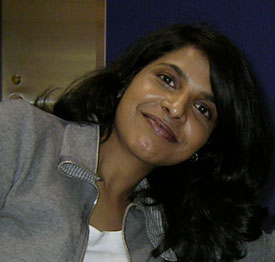By Karthika Swamy Cohen
Yeast budding during cell division and during the mating process are good examples of gradient sensing and polarization. Image credit: Timothy Elston, LS16 presentation.
Moving or projecting up
a chemical gradient is a universal feature of living organisms. Cells often
sense and respond to spatial and chemical gradients.
Timothy Elston of
University of North Carolina at Chapel Hill gave an invited talk, “Mathematical
Models for Cell Polarization and Gradient Sensing” at the SIAM Conference on
the Life Sciences being held in Boston this week. Elston described mathematical
approaches to study polarized growth and gradient sensing, two processes
essential to cellular growth. Combining mathematical analysis with experimental
observations, Elston’s group studies the biochemical and molecular mechanisms
behind directed growth and gradient sensing.
In polarized growth, a
front is maintained, allowing migration and differentiation in multicellular
organisms.When cells polarize, they distribute protein in an asymmetric
way.
Cdc-42 movement is a good example of chemotropism. Image credit: Timothy Elston, LS16 presentation.
The destabilization of uniform chemical distribution to spatial patterns at a given wave number is commonly called Turing type pattern formation. If a Turing instability is present, an as yet un-polarized cell would react to spatially varying stimulus by forming a chemical pattern and breaking symmetry. Hence, Turing instabilities are used to model polarization.
"Symmetry breaking happens in the context of polarization,” explained Elston. “Here, each individual cell can break symmetry, and this happens through Turing instability.”
Cdc-42 movement during yeast budding helps study polarization. Image credit: Timothy Elston, LS16 presentation.
Elston explained gradient sensing and polarization with examples from yeast, which undergo polarized growth in two contexts --when they form a bud during cell division, and during the mating process. While yeast are typically diploid, they can also exist as haploids a - males and alpha female. The haploids then find each other during mating by chemotropic growth. In the case of budding, internal cues are involved, and in mating, the cues are external.
Using the example of the protein Cdc-45, and its movement in the cytoplasm, he explained how polarity is established in yeast cells. Not surprisingly, Cdc-45 is essential for cell division and mating in yeast. Quite simply, Elston explained a simple model of polarity, "There's always competition and the bigger people always win." Elston described a stochastic model, which tracks the position and chemical state of each molecule. The process is analyzed in more detail by switching to reaction diffusion equations.
 |
Karthika Swamy Cohen is the managing editor of SIAM News. |